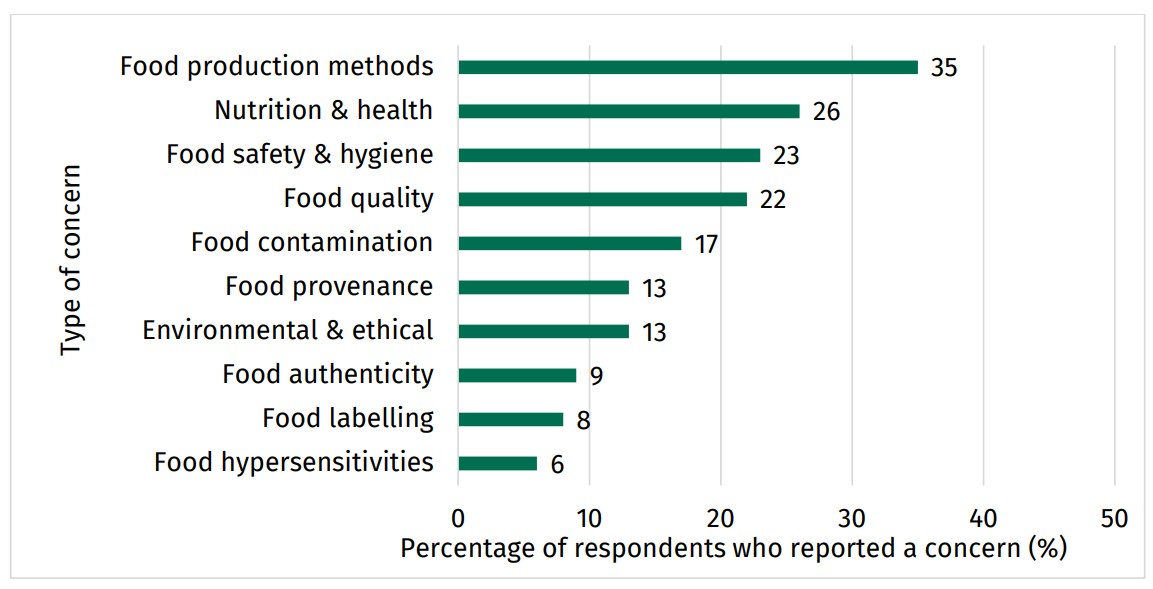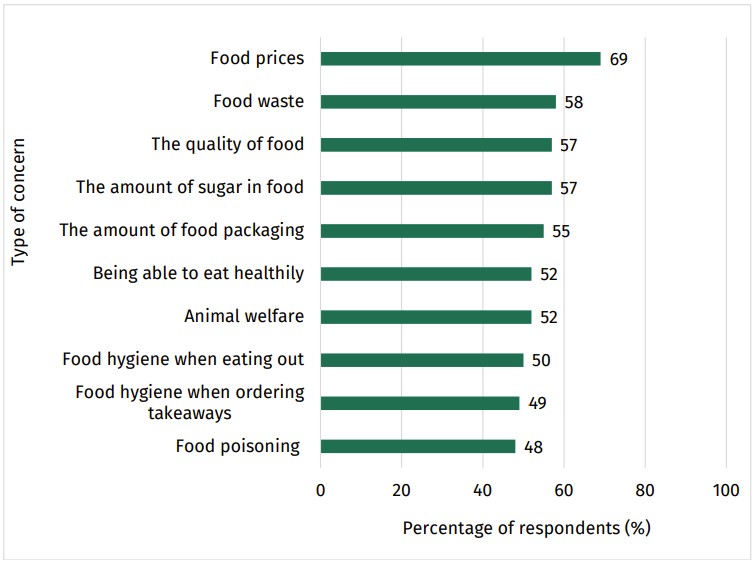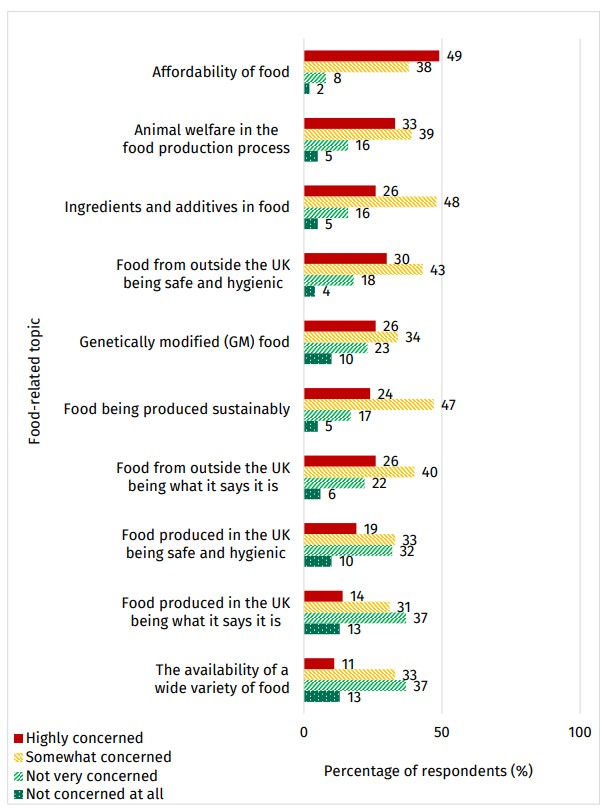F&Y2 Wave 9, Chapter 2: Concerns about food
The FSA's role, set out in law, is to safeguard public health and protect the interests of consumers in relation to food. The FSA uses the Food and You 2 survey to monitor consumers’ concerns about food issues, such as food safety, nutrition, and environmental issues. This chapter provides an overview of respondents’ concerns about food.
Common concerns
Respondents were asked to report whether they had any concerns about the food they eat. Most respondents (79%) had no concerns, and 21% of respondents reported that they had a concern (footnote 1).
Respondents who reported having a concern were asked to briefly explain what their concerns were about the food they eat. The most common concerns related to food production methods (35%), nutrition and health (26%), concerns about food safety and hygiene (23%) and the quality of food (22%) (Figure 2) (footnote 2).
Figure 2. Most common spontaneously expressed food-related concerns (top 10)

Source: Food and You 2: Wave 9
All online respondents were asked to indicate if they had concerns about several food related issues, from a list of options. The most prevalent concern was food prices (69%). Other common concerns were food waste (58%), the quality of food (57%), the amount of sugar in food (57%), and the amount of food packaging (55%) (Figure 3) (footnote 3).
Figure 3. Most common prompted food-related concerns (top 10)

Source: Food and You 2: Wave 9
Respondents were asked to indicate the extent to which they were concerned about several specific food-related issues. Respondents were most likely to report being highly concerned about the affordability of food (49%). Other issues respondents were highly concerned about included animal welfare in the food production process (33%), and food from outside the UK being safe and hygienic (30%) (Figure 4) (footnote 4).
Figure 4. Level of concern about food-related topics

Source: Food and You 2: Wave 9
The reported level of concern about the affordability of food varied between different categories of people in the following ways:
- age group: respondents aged between 16 and 54 years were more likely to report that they were highly concerned about the affordability of food than those aged between 55 and 75 years. For example, 57% of those aged 16-24 were highly concerned compared to 34% of those aged 65-74
- presence of children under 16 in the household: Households with children present (58%) were more likely to report that they were highly concerned about the affordability of food than those without children (46%)
- annual household income: respondents with a lower income were more likely to report that they were highly concerned about the affordability of food compared to households with a higher income (for example, 58% of those with an income below £19,000 compared to 32% of those with an income of £96,000 or more)
- NS-SEC: those in most occupational groups (for example, 44% of those in lower supervisory and technical occupations) were more likely to report that they were highly concerned about the affordability of food than full-time students (62%)
- food security: respondents with very low (75%), low (66%) or marginal (65%) food security were more likely to report that they were highly concerned about the affordability of food than those with high food security (39%)
- long-term health condition: respondents with a long-term health condition (57%) were more likely to report that they were highly concerned about the affordability of food then those without a long-term health condition (46%)
- awareness of the food hygiene rating scheme (FHRS): Those who had heard of the FHRS and either knew a lot or a little about it (50%) or had heard of the FHRS but didn’t know much or anything about it (49%) were more likely to be concerned about the affordability of food, compared to those who had not heard of the scheme (33%)
-
Question: Do you have any concerns about the food you eat? Responses: Yes, No. Base = 5526, all respondents.
-
Question: What are your concerns about the food you eat? Responses: [Open text]. Base= 1100, all respondents with concerns about the food they eat. Please note: additional responses are available in the full data set and tables, responses were coded by Ipsos, see Technical Report for further details.
-
Question: Do you have concerns about any of the following? Responses: the amount of sugar in food, food waste, animal welfare, hormones, steroids or antibiotics in food, the amount of salt in food, the amount of fat in food, food poisoning, food hygiene when eating out, food hygiene when ordering takeaways, the use of pesticides, food fraud or crime, the use of additives (for example, preservatives and colouring), food prices, genetically modified (GM) foods, chemical contamination from the environment, food miles, the number of calories in food, food allergen information, cooking safely at home, the quality of food, the amount of food packaging, being able to eat healthily, none of these, don’t know. Base= 3530, all online respondents.
-
Question: Thinking about food in the UK [question wording variation in Northern Ireland: the UK and Ireland] today, how concerned, if at all, do you feel about each of the following topics? a) affordability of food b) food produced in [in England and Wales: the UK; [in Northern Ireland: the UK and Ireland] being safe and hygienic c) food from outside [in England and Wales: the UK; in Northern Ireland: the UK and Ireland] being safe and hygienic d) food produced in [in England and Wales: the UK; in Northern Ireland: the UK and Ireland] being what it says it is e) food from outside [in England and Wales: the UK; in Northern Ireland: the UK and Ireland] being what it says it is f) food being produced sustainably g) the availability of a wide variety of food h) animal welfare in the food production process i) ingredients and additives in food j) genetically modified (GM) food. Base = 3530, all online respondents. Please note: some question wording was modified for respondents in England, Wales and Northern Ireland.